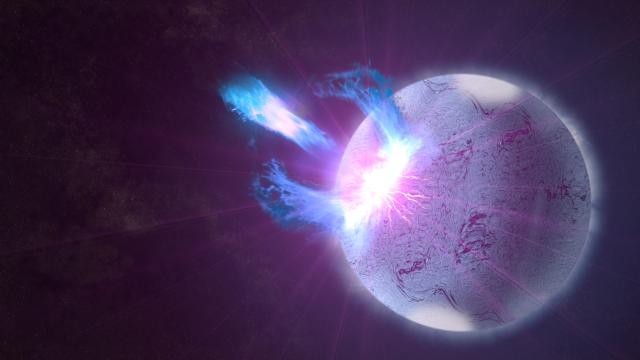Artist’s depiction of a rupturing magnetar — a rotating neutron star with an extremely strong magnetic field. These exotic objects could be the source of the mysterious cosmic bursts observed by scientists. (Image: NASA’s Goddard Space Flight Center/S. Wiessinger)
Scientists on the hunt for signs of extraterrestrial intelligence have detected 15 Fast Radio Bursts from a dwarf galaxy located three billion light-years away. Though likely not produced by aliens, the new observations could tell us more about these mysterious and powerful cosmic pulses.
A long time ago in a galaxy far, far away, something — we don’t know what — produced 15 brief but very powerful radio pulses that, after three billion years, finally reached Earth. Known as Fast Radio Bursts (FRBs), these pulses have confounded scientists since they were first discovered a decade ago by astronomers using the Parkes radio dish in Australia.
The source of these latest bursts, called FRB 121102, is the first to produce repeating FRBs, and this most recent batch of 15 pulses is further reaffirming its repeating nature. The fact that these things repeat strongly rules out a catastrophic source, such as a supernova explosion. Astronomers have now detected over 150 “high-energy pulses” from FRB 121102, which was discovered in 2012 and identified last year as coming from a dwarf galaxy.
The 15 new FRBs were detected by scientists working on the Breakthrough Listen project — a 10-year mission to search the skies for signs of extraterrestrial intelligences (ETIs). Using the Green Bank Radio Telescope in West Virginia, the Breakthrough Listen team at UC Berkeley picked up the unusual signals on Monday August 28th. The larger astronomical community was quickly alerted.

This sequence shows 14 of the 15 detected bursts. (Image: Berkeley/Breakthrough Listen)
Scientists don’t yet know the cause of these bursts, so naturally explanations range from the conservative through to the highly speculative.
“The conservative explanation for repeating FRBs is that they originate from a spinning neutron star which acts as a lighthouse [known as magnetars],” Avi Loeb, Chair of Harvard’s Astronomy Department, told Gizmodo. “Its beam of radiation is sweeping across the sky again and again because the star is subject to some external force that jolts it around. The circumstances must be different from a pulsar where the beam…is visible to the observer with an exact periodicity. FRBs appear to repeat in a non-periodic fashion. Moreover, FRBs are ten billion times brighter than pulsars, so the neutron star must be special, possibly very young (10-100 years old) and with a very strong magnetic field, producing much more powerful radiation than a typical pulsar.”
Much more speculatively, Loeb has posited FRBs might be artificially produced by an ETI’s antenna array for lightsail propulsion (similar to Breakthrough Starshot’s plan to send a lightsail to Proxima Centauri), and the repetitions are simply due to multiple firings of the launch system combined with the complicated motion of the beamer (on the source planet) relative to us.
“But as Mark Twain said, ‘It ain’t what you don’t know that gets you into trouble. It’s what you know for sure that just ain’t so’,” cautioned Loeb. “We should therefore wait for more data before jumping to conclusions.”
Thankfully, the latest observations could provide scientists with that much needed extra data. Bursts from this source have never been seen at such high frequencies, explained Andrew Siemion, director of the Berkeley SETI Research Center and Breakthrough Listen, the highest of which reached 7 GHz. The Berkeley researchers say the high resolution data that they acquired will now enable scientists to measure the properties of FRBs at higher levels of precision than ever before. Over 400 terabytes of data was pulled in over a five hour period, as the researchers scanned the 4 to 8 GHz frequency band. The analysis by Siemion and Breakthrough Listen postdoctoral researcher Vishal Gajjar revealed the 15 new pulses.
“The extraordinary capabilities of the backend receiver, which is able to record several gigahertz of bandwidth at a time, split into billions of individual channels, enable a new view of the frequency spectrum of FRBs, and should shed additional light on the processes giving rise to FRB emission.” Gajjar said.
Which is all very encouraging — hopefully we’ll get to the bottom of this cosmic mystery shortly.
“We clearly have much more to learn about FRB 121102, and FRBs in general,” Siemion told Gizmodo. “While it would be unwise to exclude the possibility that there are is other intelligent, technologically-capable, life in our universe, it is also unwise to immediately ascribe any new and poorly-understood astronomical phenomena to the work of alien life.”
For now, Siemion says the most likely explanations for FRB 121102 are natural ones.
“As has happened with myriad other ‘strange’ phenomena (the CMB, pulsars themselves, gamma ray bursts, etc), we will probably find a natural explanation for FRB 121102 that, while not having to do with extraterrestrial intelligence, will never-the-less teach us something new about the universe,” he said.
